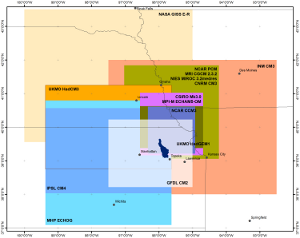Environmental impacts of climate change
Climate change impacts watershed hydrology and contributes to alteration of hydrologic regimes in streams. However, global climate models (GCMs) operate at spatial and temporal scales that are too large to capture important watershed-scale hydrologic shifts. A method of disaggregating monthly ensemble GCM data into temperature and precipitation data series for daily, watershed-specific hydrologic simulations with SWAT was developed and assessed in several watersheds in Kansas. A stochastic weather generator WINDS was employed to produce a baseline scenario (no changes from late 20thcentury conditions) and a set of scenarios based on ensemble means or seasonal shifts acquired from GCMs representing future conditions (A2 storyline). One example of GCM coverage grid-cells centered over one HUC-10 watershed in Northeast Kansas is demonstrated below:

Future hydrologic regimes exhibited non-linear annual and monthly responses in hydrologic budget components, such as surface runoff, baseflow, and soil moisture, to temperature and precipitation changes. While annual changes are important, the study discovered an increased significance of accounting of monthly and seasonal changes in predicting alterations of hydrologic regimes, stream flows, and freshwater ecosystems with potential climate change. Specifically for the Midwestern region, the increased number of precipitation events in spring and dryer summer months could lead to additional stress on terrestrial and fresh water ecosystems. A prediction of more than 2 C increase in average annual temperatures and seasonal change in mean monthly temperatures could affect distribution of snow cover and hydrologic regimes in the streams and cause shifts in population range resulting in local extinction of certain species.
Watershed management under climatic change
Climate change and associated shifts in weather patterns and land-use conditions can significantly affect sustainability of current states of the watersheds. Utilization of climate change scenarios in watershed management plans such as EPA Nine Element Plans can improve distribution of critical areas and potentially lead to better watershed management in the future.
Understanding the hydrologic and water-quality impacts of climate change in agricultural watersheds is crucial for watershed management and planning. Presently employed watershed management and planning activities account for watershed conditions that are either monitored or simulated with knowledge of past and presence but do not account for changes in future. Adjustments to watershed management plans development are necessary in order to understand and plan for the adverse effects of climate change on water resources. Evaluation of many realizations of the uncertain future and the consequent impact on watershed conditions must be conducted to improve short term and long term watershed management planning strategies.
Relevant publications:
- Sheshukov, A.Y., C. Siebenmorgen, and K.R. Douglas-Mankin (2011) Seasonal and Annual Impacts Of Climate Change On Watershed Response Using Ensemble Of Global Climate Models, Transactions of the ASABE, 54(6).
- Wilson, B.N., and A.Y. Sheshukov (2011) Precipitation Parameters of Stochastic Weather Models for a Changing Climate, ASABE International Symposium on Erosion and Landscape Evolution, Anchorage, AK, 8 p.
- Siebenmorgen, C.B., A.Y. Sheshukov, and K.R. Douglas-Mankin (2010) Climate Change Impacts on Hydrologic Indices in Unregulated Watersheds in Kansas, TMDL 2010: Watershed Management to Improve Water Quality, ASABE Conference. Baltimore, MD. 8 p.
